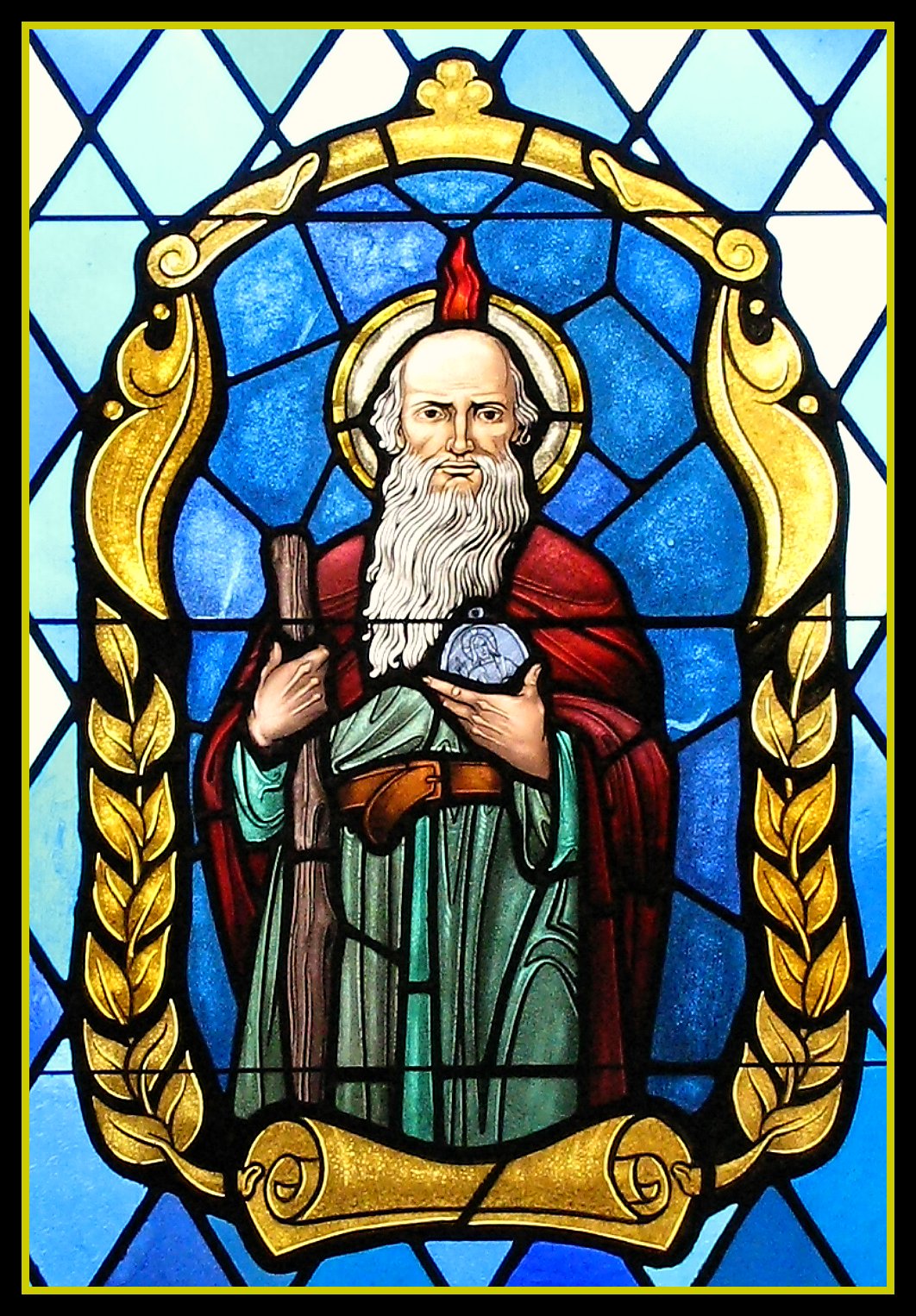
This is magnificent stain glass portrait of Saint Jude Thaddeus – Saint of Hopeless Causes is one of my favorite Traditional Saints. From what I understand there been as many as 10,000 Catholic Saints. Today, they note, that there are only 810 canonized saints – these are the Saints who have passed through the formal institutional process of canonization, but that number is in flux – Pope Francis as of now, has added 36, including Mother Teresa and Pope John Paul II. I’ll come back to the process of being canonized later, in a later article and we will check on the number again.
I first heard about Saint Jude while reading about the comedian/actor/TV Producer Danny Thomas, no relation to me. Danny is the son of Maronite Catholic immigrants from Lebanon. His real name is Amos Muzyad Yakhoob Kairouz (January 6, 1912 – February 6, 1991). Thomas was raised in Toledo, Ohio and attending St. Francis de Sales Church and was raised as a Roman Catholic. He is Marlo Thomas’s dad (That Girl), but more important he was a major force in the evolution of television. With Sheldon Leonard and Aaron Spelling they produced The Dick Van Dyke Show, The Andy Griffith Show, The Mod Squad and Walter Brennan in The Real McCoys, but that not the story I’m telling.

A “starving actor” in the 1940’s, Thomas had made a vow: If he found success, he would open a shrine dedicated to St. Jude Thaddeus, the patron saint of the hopeless. Thomas never forgot his promise to St. Jude and, after becoming a successful actor in the early 1950s, his wife joined him and began traveling the United States to help raise funds to build his dream – St. Jude Children’s Research Hospital. He fervently believed “no child should die in the dawn of life.” With help of others like Dr. Lemuel Diggs and close friend, Anthony Abraham, an auto magnate in Florida, Thomas founded the St. Jude Children’s Research Hospital in Memphis, Tennessee in 1962. Since its inception, St. Jude has treated children from all 50 states and around the world, continuing the mission of finding cures and saving children. Dr. Peter C. Doherty of St. Jude’s Immunology Department, was a co-recipient of the Nobel Prize in Physiology or Medicine in 1996 for key discoveries on how the immune system works to kill virus-infected cells. 1.

In 1983, President Ronald Reagan presented Thomas with a Congressional Gold Medal honoring him for his work with St. Jude Children’s Research Hospital.
 Now let’s get back to Saint Jude or Judas Thaddaeus. A caution here – believers hate a “hole” in the narrative and there is an inherent tendency to fill in the story. We forget that many of the early Christian Church fought the good fight, with many of them faithfully paying for their faith with their lives in the arena.
Now let’s get back to Saint Jude or Judas Thaddaeus. A caution here – believers hate a “hole” in the narrative and there is an inherent tendency to fill in the story. We forget that many of the early Christian Church fought the good fight, with many of them faithfully paying for their faith with their lives in the arena.

“The Christian Martyrs’ Last Prayer” by Jean-Leon Gerome 1883.
The Book of Acts tells us about Stephen, a seventy (Acts: 6: 1 – 5), who was tried and then stoned to death in Acts 6 and 7 (He has a vision just before his death that is much like Joseph Smith’s). James the Great, John’s brother, sons of Zebedee and member of the Early Church’s First Presidency was killed by Herod Agrippa I, Herod’s son, with a sword in Acts 12. And note, life became precarious for all believers from that time forth. And by the by, let’s not forget the Babes of Bethlehem and Zechariah Priest of the course of Abia, whose wife Elizabeth gave birth to John the Baptist was killed too, as was his son John the Baptist. People gave they’re all from the get go for the Gospel.
Once we leave the safety of the scriptures we become dependent on the Early Christian Father, many of whom were ordained and set apart by the Apostles and we have full confidence in their intent. But along with the Apologists, who sought to explain and justify Christian beliefs the facts become jumbled and conflicting. Even the New Testament’s 27 books were not validated as canon by Saint Athanasius until 367 AD. Hey we didn’t even have an Old and New Testament until Saint Jerome finish the Vulgate Bible (Vulgate means vulgar because it was Latin, not Greek or Hebrew) in 382 AD.
Now, with the caution above and the realization blanks are being filled in, my “internet walkabout” tells me that Jude or Jude Thaddeus was the son of Cleophas 2. (Luke 24: 18).
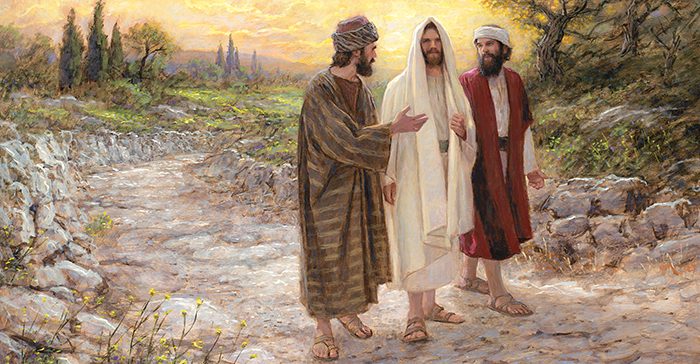 This painting The Road to Emmaus by Jon McNaughton portrays a moment from Luke 24: 13 – 34. Now Jesus might be walking with his Uncle and whose the other fellow.
This painting The Road to Emmaus by Jon McNaughton portrays a moment from Luke 24: 13 – 34. Now Jesus might be walking with his Uncle and whose the other fellow.
Some say, Cleophas was Joseph the Virgin Mary’s husband’s brother. And this would explain why Wedding at Cana, supposedly Jude’s Wedding generated Aunt Mary’s concern over the wine (John 2: 1 – 11). So Jude was Jesus’s cousin and one of the original 12 Apostles. He is sometimes identified with Jude the brother of Jesus. Tradition holds that Saint Jude preached the Gospel in Judea, Samaria, Idumaca, Syria, Mesopotamia and Libya. He might be the Apostle to the Middle East, talk about impossible causes. The island, below, that looks like a stingray is Cyprus, you can see where Israel is – anywhere you see grayish green is Israel. Syria, Jordan, Lebanon, Palestine and the Northern Sinai all of em, in the news, are there. This was all Jude’s turf and he went north and east into Turkey, Armenia and even Kyrgyzstan – part of Mogol Empire.
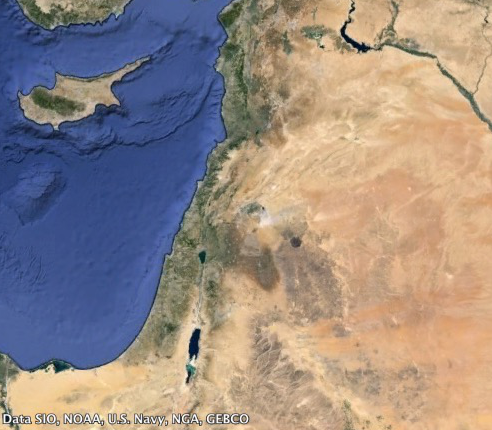
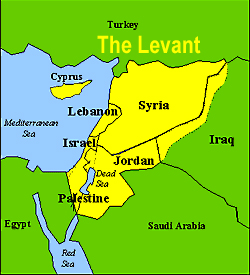
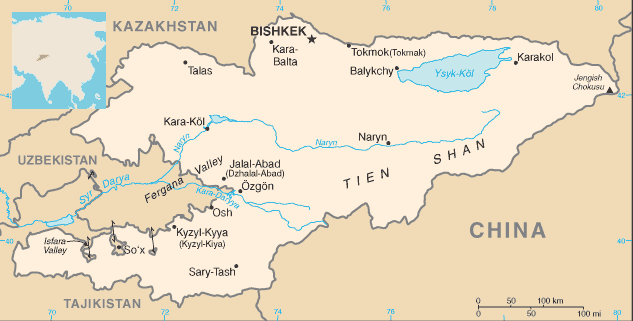
Now I apologize for the speaking voice of this video. He sounds like Stephen Hawkings, but the info is good as far as generic folklore is concerned.
As noted Jude Thaddeus is the “patron saint of lost causes” This practice stems from the belief that few Christians invoked him for misplaced fear of praying to Christ’s betrayer, Judas Iscariot, because of their similar names. The ignored Jude thus supposedly became quite eager to assist anyone who sought his help, to the point of interceding in the most dire of circumstances. The Church also wanted to encourage veneration of this “forgotten” disciple, and maintained that Saint Jude would intercede in any lost cause to prove his sanctity and zeal for Christ. According to tradition, after his martyrdom, pilgrims came to his grave to pray and many of them experienced the powerful intercessions of St. Jude. Thus the title, ‘The Saint for the Hopeless and the Despaired’. St. Bridget of Sweden and St. Bernard had visions from God asking each to accept St. Jude as ‘The Patron Saint of the Impossible’.
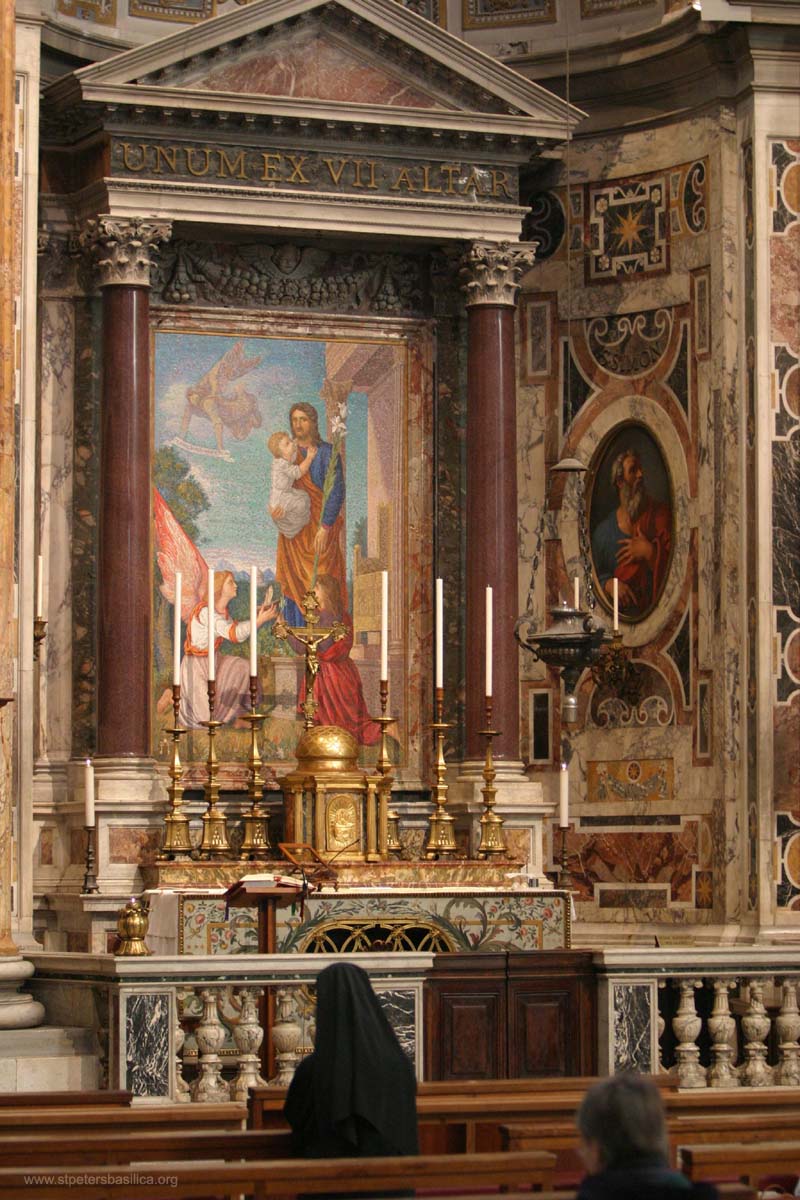
Jude Thaddeus Tomb in Saint Peter’s in Rome.
After his martyrdom, the body of St. Jude was buried temporarily in Mesopotamia and them given permanent internment in St. Peter’s Basilica in Rome – a grave Reliquary. A reliquary (also referred to as a shrine) is a container for relics. These may be the purported or actual physical remains of saints, such as bones, pieces of clothing, or some object associated with saints or other religious figures.
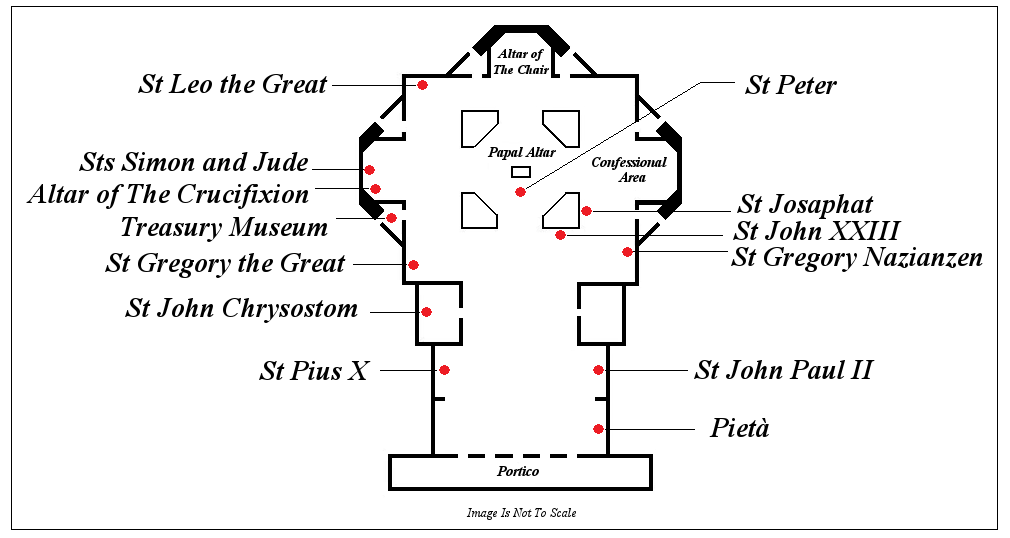
This is a map of the graves of Saints just under the dome of Saint Peter’s Cathedral – Famous Popes and two Apostles – Jude and Peter. The Vatican was originally a dump for the bodies of the victims of the Colosseum – Gladiators and Christians. A trash heap for the pagans, but holy ground to the Christians.
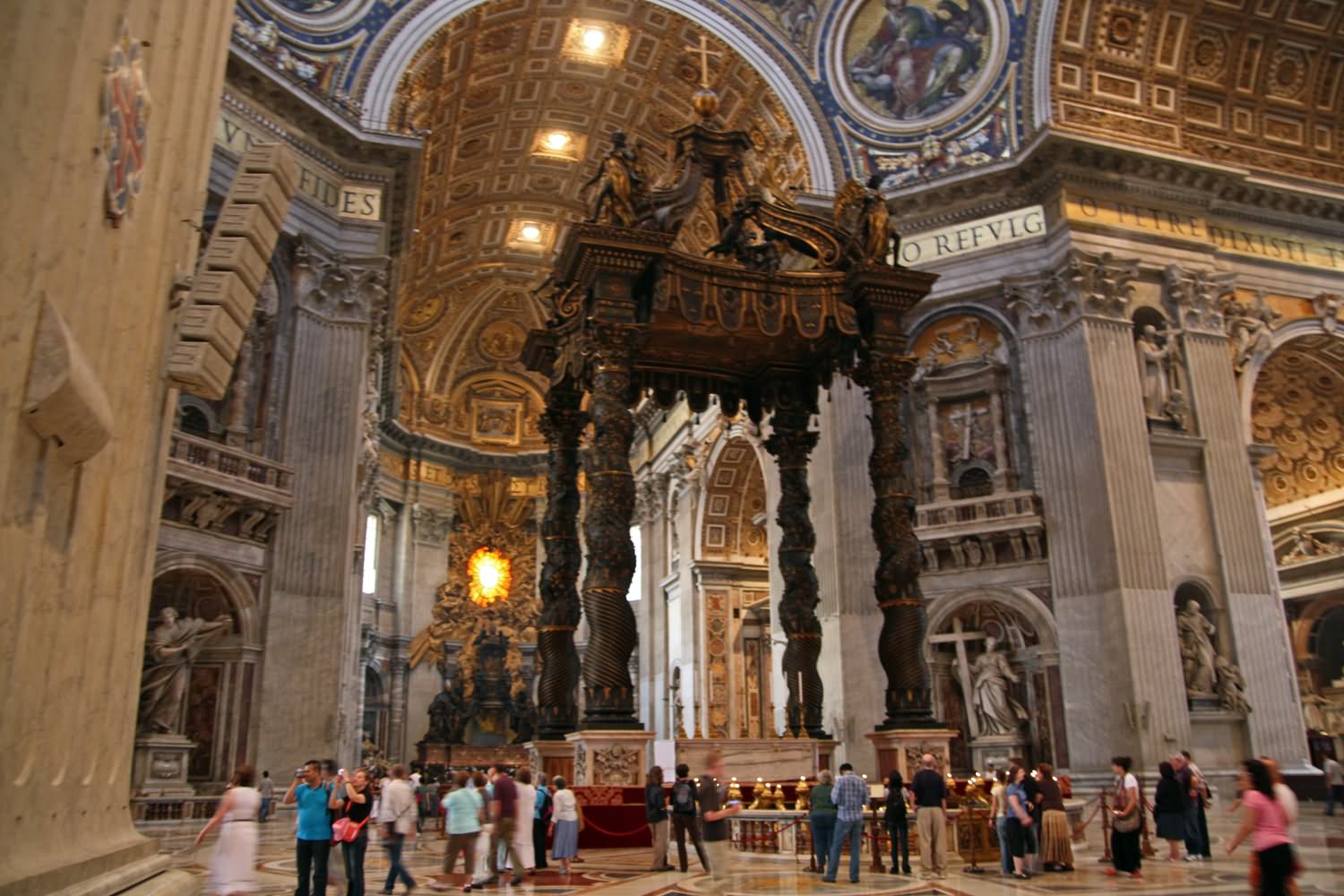
My own experience with Saint Jude took place on two occasions. The first was in Rome in 2004. We went to Saint Peter’s Cathedral on a Wednesday. What we didn’t know was that Pope John Paul II was going to appear and take audiences for the first time after a battle with Parkinson Disease.
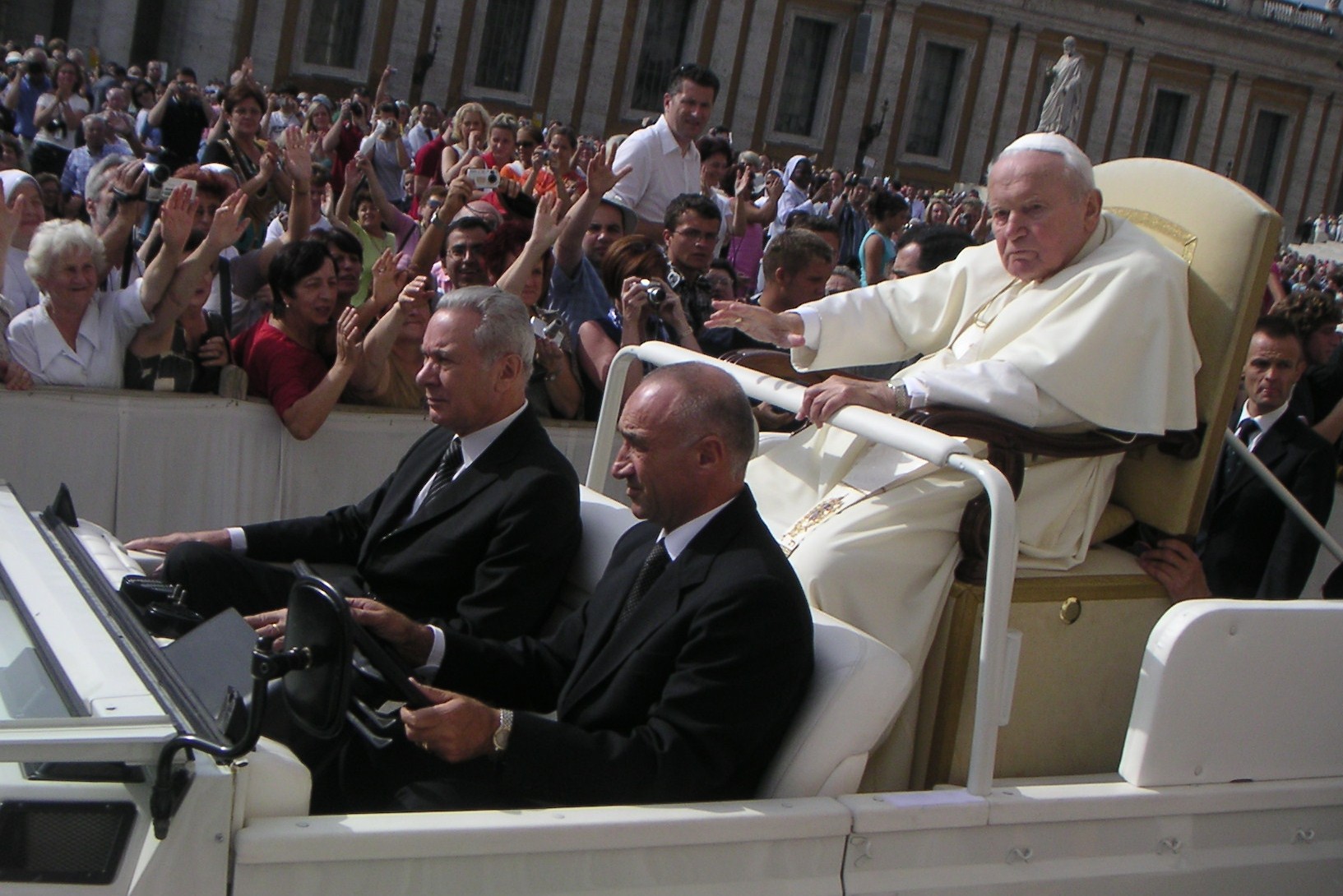 The Cathedral and Vatican Museum were crazy with crowds (We try to cover it in an hour – asinine). The traffic was bumper to bumper getting out of Rome and back to our cruise ship – the fact that we had 45 minutes to cover an hour and half ride back was a stressor because Our Cruise Ship, because we were a private tour, told us they’d leave us if we were late. I felt we were in an impossible situation so as the guide for the tour I felt it was time to introduce our guests to Saint Jude and maybe send up an appeal for help. Believe it or not, we made it, with Jude’s help our driver got in front of the cruise lines ship’s tour buses. They’d have to wait for them so we were in the clear. Thanks Jude.
The Cathedral and Vatican Museum were crazy with crowds (We try to cover it in an hour – asinine). The traffic was bumper to bumper getting out of Rome and back to our cruise ship – the fact that we had 45 minutes to cover an hour and half ride back was a stressor because Our Cruise Ship, because we were a private tour, told us they’d leave us if we were late. I felt we were in an impossible situation so as the guide for the tour I felt it was time to introduce our guests to Saint Jude and maybe send up an appeal for help. Believe it or not, we made it, with Jude’s help our driver got in front of the cruise lines ship’s tour buses. They’d have to wait for them so we were in the clear. Thanks Jude.
Second time was when we visited a Catholic Church in Hawaii and I bought a Saint Jude’s Medal.
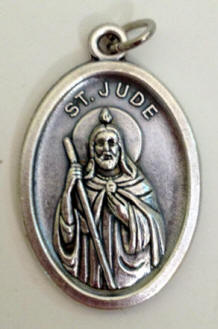 I took Thaddeus on all my Tours after that. For fun and security and lots of intelligent people call upon the Saints, even good Jewish Boys. Consider this appeal to Cecilia the Patron Saint of Musicians. But, remember, Hey Jude by Paul MacCarty is not about Saint Jude. 2.
I took Thaddeus on all my Tours after that. For fun and security and lots of intelligent people call upon the Saints, even good Jewish Boys. Consider this appeal to Cecilia the Patron Saint of Musicians. But, remember, Hey Jude by Paul MacCarty is not about Saint Jude. 2.
You’re shaking my confidence daily
Oh, Cecilia, I’m down on my knees
I’m begging you please to come home
You’re shaking my confidence daily
Oh, Cecilia, I’m down on my knees
I’m begging you please to come home
Come on home…….
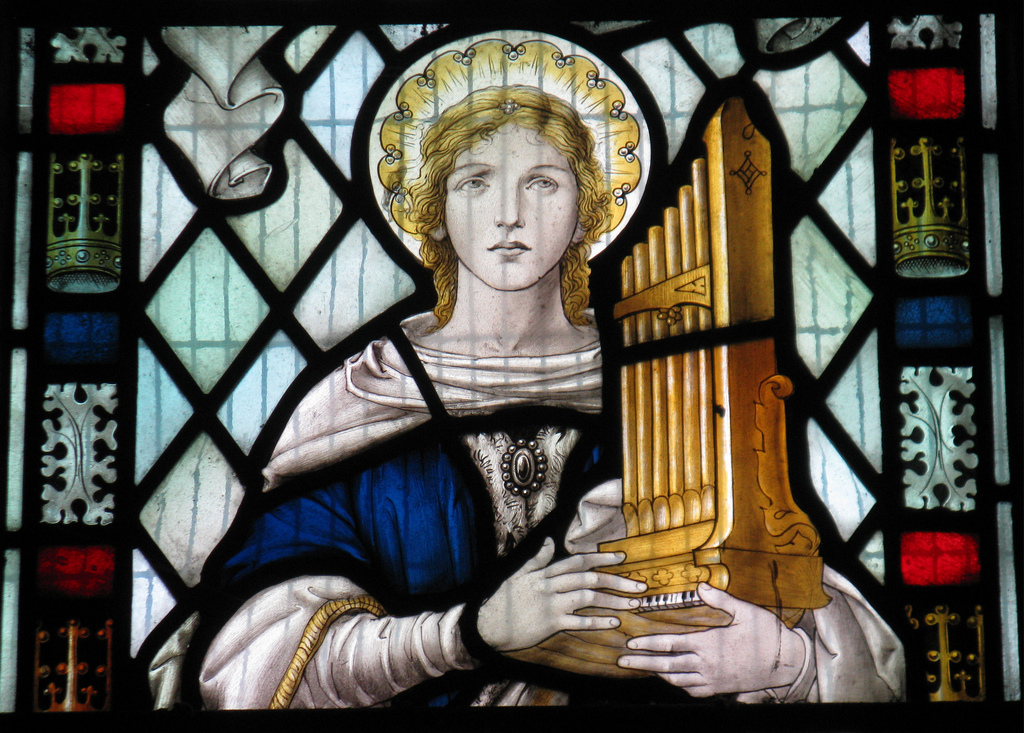
According to the story, despite her vow of virginity, she was forced by her parents to marry a pagan nobleman named Valerian. During the wedding, Cecilia sat apart singing to God in her heart, and for that she was later declared the saint of musicians. When the time came for her marriage to be consummated, Cecilia told Valerian that watching over her was an angel of the lord, who would punish him if he sexually violated her, but would love him if he respected her virginity. When Valerian asked to see the angel, Cecilia replied that he could if he would go to the third milestone on the Via Appia and be baptized by Pope Urban I. After following Cecilia’s advice, he saw the angel standing beside her and crowning her with a garland of roses and lilies. Hey Rabbi Paul Simon is really singing to her. There are other modern songs that refer to her.
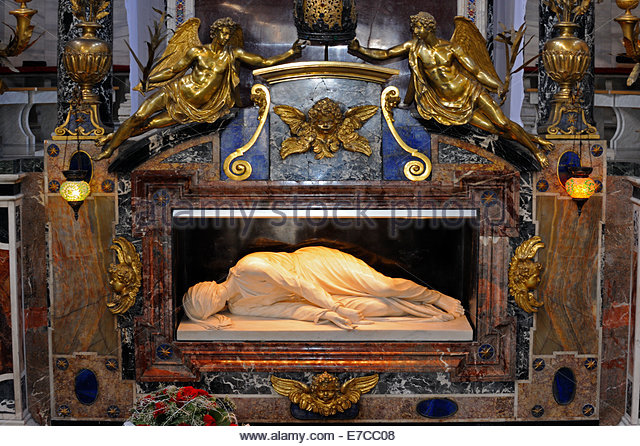 Saint Cecilia Grave in Santa Cecilia in Trastevere, Rome.
Saint Cecilia Grave in Santa Cecilia in Trastevere, Rome.

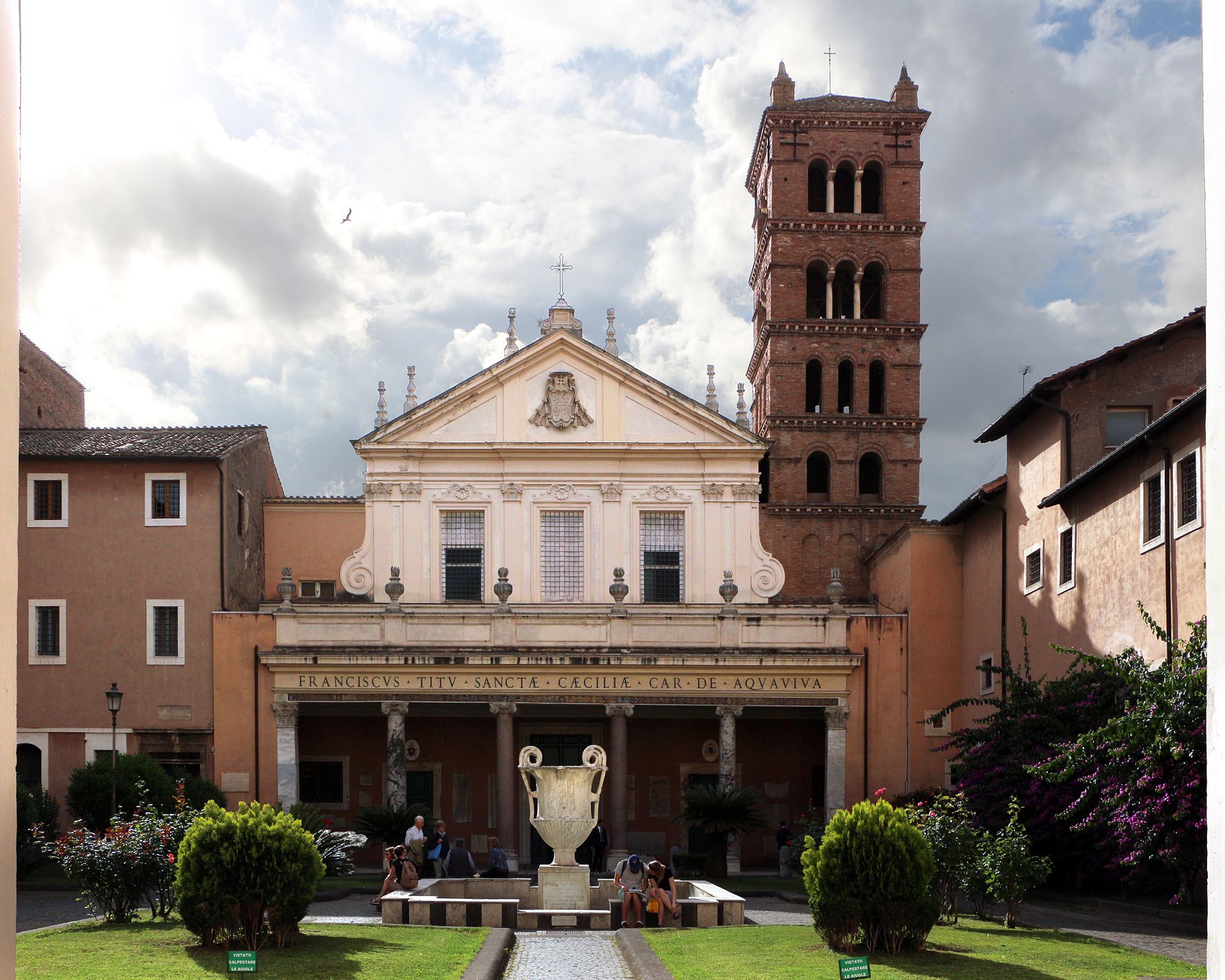
- Wikipedia on Danny Thomas help here, but I read about this when I was just a kid.
- In the Book of Luke 24
13 And, behold, two of them went that same day to a village called Emmaus, which was from Jerusalem about threescore furlongs.
14 And they talked together of all these things which had happened.
15 And it came to pass, that, while they communed together and reasoned, Jesus himself drew near, and went with them.
16 But their eyes were holden that they should not know him.
17 And he said unto them, What manner of communications are these that ye have one to another, as ye walk, and are sad?
18 And the one of them, whose name was Cleopas, answering said unto him, Art thou only a stranger in Jerusalem, and hast not known the things which are come to pass there in these days?
19 And he said unto them, What things? And they said unto him, Concerning Jesus of Nazareth, which was a prophet mighty in deed and word before God and all the people:
20 And how the chief priests and our rulers delivered him to be condemned to death, and have crucified him.
21 But we trusted that it had been he which should have redeemed Israel: and beside all this, to day is the third day since these things were done.
22 Yea, and certain women also of our company made us astonished, which were early at the sepulchre;
23 And when they found not his body, they came, saying, that they had also seen a vision of angels, which said that he was alive.
24 And certain of them which were with us went to the sepulchre, and found it even so as the women had said: but him they saw not.
25 Then he said unto them, O fools, and slow of heart to believe all that the prophets have spoken:
26 Ought not Christ to have suffered these things, and to enter into his glory?
27 And beginning at Moses and all the prophets, he expounded unto them in all the scriptures the things concerning himself.
28 And they drew nigh unto the village, whither they went: and he made as though he would have gone further.
29 But they constrained him, saying, Abide with us: for it is toward evening, and the day is far spent. And he went in to tarry with them.
30 And it came to pass, as he sat at meat with them, he took bread, and blessed it, and brake, and gave to them.
31 And their eyes were opened, and they knew him; and he vanished out of their sight.
32 And they said one to another, Did not our heart burn within us, while he talked with us by the way, and while he opened to us the scriptures?
The historian, Bishop Eusebius of Caesarea quotes the earlier chronicler, Hegesippus, who wrote, c. AD 180, that he had years before interviewed the grandsons of Jude the Apostle and learned that Cleophas, Jude Thaddeus’s father, was the brother of Joseph, husband of the Virgin Mary: “After the martyrdom of James, it was unanimously decided that Simeon, son of Cleophas, was worthy to occupy the see of Jerusalem. He was, it is said, a cousin of the Saviour.” Hegesippus noted that Cleophas was a brother of Joseph (Eusebius, Hist. eccl., III, 11). Epiphanius adds that Joseph and Cleopas were brothers, sons of “Jacob, surnamed Panther.” IF
Jude is Jesus’s cousin and Joseph’s nephew, then The Virgin Mary’s concern about the wedding refreshments at Cana, what some said was Jude’s wedding.Early Christian Fathers and Apologists are INTERESTING sources for “fill in the blank parts” of the Christians History after 100 AD, but there is a lot of “he said that she said” information, so INTERESTING yes, but caution should be applied. Eusebius (260/265 – 339/340 AD) was a Greek historian of Christianity, Together with Pamphilus (3rd century – February 16, 309), he was a scholar of the Biblical canon and is regarded as an extremely well learned Christian of his time.
- Lynne Hilton Wilson, “The Confusing Case of Zacharias,” in BYU Religious Educator 14, no. 2 (2013) 107–123. Referencing Protevangelium “And Elisabeth, having heard that they were searching for John, took him and went up into the hill-country. . . . And Herod searched for John, and Herod was enraged, and said: . . . [Zacharias’] son is destined to be king over Israel. And he sent . . . [to the temple] again, saying: Tell the truth; where is thy son? for thou knowest that thy life is in my hand. And Zacharias said: I am God’s martyr, if thou sheddest my blood; for the Lord will receive my spirit, because thou sheddest innocent blood at the vestibule of the temple of the Lord. And Zacharias was murdered about daybreak . . . [his] clotted blood beside the altar.”
- “Hey Jude, don’t make it bad / Take a sad song and make it better / Remember to let her into your heart / Then you can start to make it better…” is actually a song of comfort written by Paul for Julian Lennon who was heart broken about his dad and mom’s divorce. The original title for the song was “Hey Jules.”
